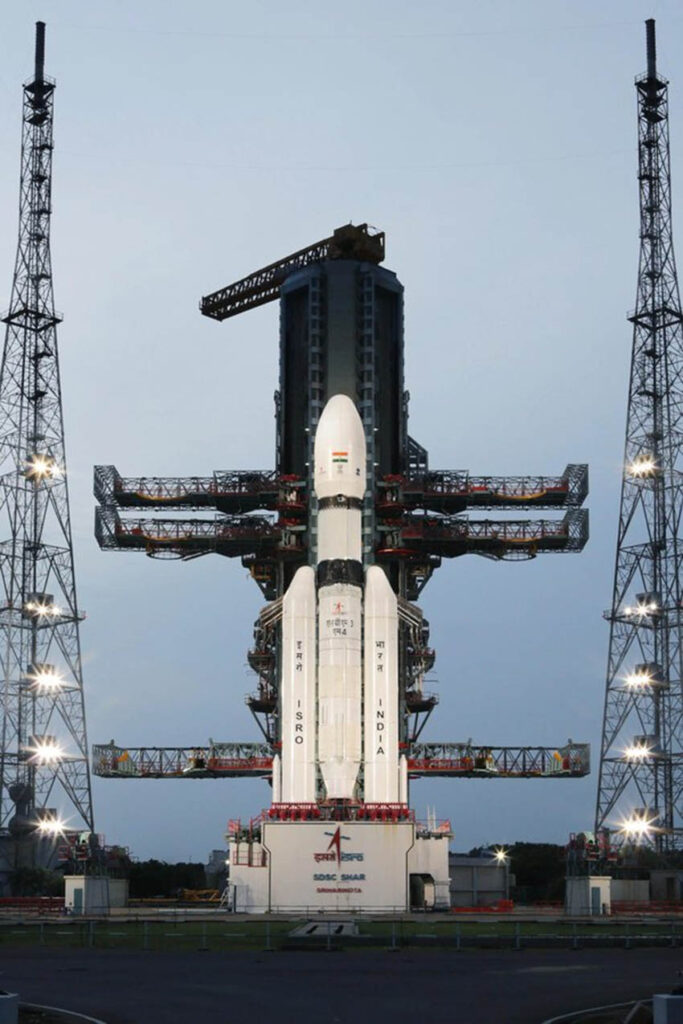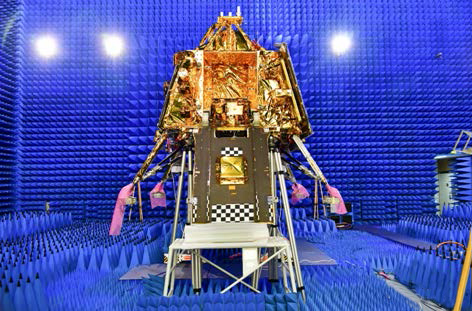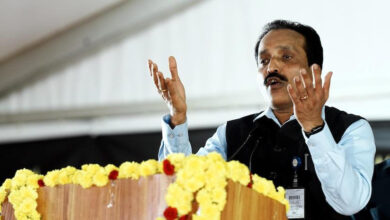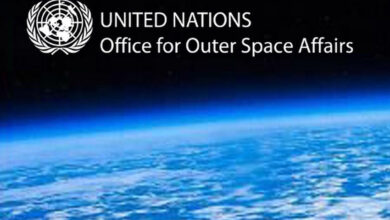Chandrayaan-3: Indian Launch for Dominance in Space
By Gp Capt (Dr) DK Pandey
New Delhi. The launch of the ‘India’s National Space Research Organisation’s (ISRO) ambitious project ‘Chandrayaan-3‘ on 14th July from the Satish Dhawan Space Centre in Sriharikota, using the heavy-lift Geosynchronous Satellite Launch Vehicle Mark III (GSLV Mark III) rocket was a landmark success. The mission aims to demonstrate end-to-end landing and roaming capabilities by placing a lander and Rover on the lunar highlands near the south pole. The spacecraft will additionally gather a variety of scientific observations both on the surface and from orbit.

Glorious Missions of ISRO
ISRO has a stellar track record, successfully launching 342 foreign satellites from 34 countries and 114 spacecraft missions (including three nanosatellites and one microsatellite).
The GSLV Mk III rocket is among ISRO’s most powerful rockets and can carry substantial payloads into orbit. Its creation has taken a considerable amount of time. In 2017, ISRO reached a critical milestone with the launch of its test vehicle. Multiple subsequent missions used this rocket, most notably India’s Chandrayaan-2 mission to the Moon in 2019. Now it is planned to take Chandrayaan-3.
The first journey to the moon, known as Chandrayaan-1, was successfully operational for 312 days until it ran out of fuel on August 25, 2009. The mission was started on October 22, 2008, and it lasted till that date. When India’s last lunar mission, Chandrayan-1, found water on the surface of the Moon for the very first time, it propelled the country to the forefront of scientific discovery worldwide. The National Aeronautics and Space Administration (NASA) in the United States and other space agencies worldwide reacted very anxiously to this news.
Another well-known example is the Mars Orbiter Mission (MOM), which started on November 5, 2013. On September 24, 2014, the Spacecraft made history by being the first to enter orbit around Mars on its very first attempt successfully. Mangalyaan stayed operational for nearly six years, until September 24, 2020, even though it was originally meant to have a lifetime of just one year when it was put into service.
ISRO successfully launched India’s largest LVM3 rocket with 36 satellites from Sriharikota, Andhra Pradesh’s Satish Dhawan Space Centre. On March 26, 2023, ISRO launched LVM3, the largest giant rocket ever built. LVM3 belonged to the One Web Group of the United Kingdom.

Chandrayaan-3 Mission Settings
The unmanned lunar exploration project ‘Chandrayaan-3‘ is the successor to the Chandrayaan-2 mission, which intended to deploy a Rover on the lunar South Pole. The failure of the Vikram lander on September 7, 2019, prompted the pursuit of a second mission to demonstrate the landing capabilities required for the proposed 2024 Lunar Polar Exploration Mission in partnership with Japan. The rigorous conditions that the Chandrayaan-3 spacecraft would be subjected to during its launch and following voyage were successfully tested, and the results confirmed the Spacecraft’s capacity to perform as expected.
The theme of the mission is “Science of the Moon”. The Spacecraft Chandrayaan-3 has the following objectives as part of its mission:
(a) To demonstrate a Smooth and Safe Touchdown on the Surface of the Moon,
(b) To demonstrate how the Rover can go around the Moon using its onboard navigation system,
(c) To study the various aspects of the Moon, including the Lunar environment and thermo-physio properties inside the natural environment.
The mission is aimed at better understanding the Moon’s composition.
The two main parts of the spacecraft are the lander/rover and the engine module. The lander/rover will have comparable features to Chandrayaan 2’s Vikram rover, with some upgrades for safety. The mission’s goal is to land on the surface and deploy the Rover, despite the challenging circumstances of the terrain. The propulsion module will take it into lunar orbit, where it will stay as a communications relay satellite. Spectrometers, a seismometer, and a heat flow experiment will all be aboard the Rover. An elliptical parking orbit of around 170 by 36,500 km will be established for Chandrayaan-3. The lander/rover will enter a polar lunar orbit 100 km in diameter and then detach using the thruster module.
The Lander and Rover will subsequently make a soft landing in the south polar area of the Moon, at around 69.37 South, 32.35 East. The target touchdown speed is less than 2 m/s in the vertical and 0.5 m/s in the horizontal. The communications relay satellite/propulsion module will stay in lunar orbit to maintain contact with Earth. The Lander and Rover can function for one lunar day (about 14 days on Earth).
State-of-art Technology
The Chandrayaan-3 spacecraft has indigenous state-of-the-art systems to ensure successful mission accomplishments. The fuel capacity of Chandrayaan-3 has been enhanced, and the landing legs have been strengthened. It features larger solar panels to generate more power and is equipped with additional sensors. It is equipped with the cutting-edge ‘Laser Doppler Velocimeter’ for precise velocity measurement, enabling controlled progress of the mission.
The Spacecraft has a Lander module (LM), Propulsion module (PM), and Rover to test and showcase new technologies required for interplanetary missions. To perform an in-situ chemical analysis of the lunar surface, the Lander will release the Rover once it has successfully soft-landed at a preset spot on the Moon.
In order to complete the objectives of the mission, Lander is outfitted with a variety of cutting-edge technologies, like: the Powered Descent Trajectory and its corresponding navigation, guidance, and control software components; the Laser Doppler Velocimeter; the Lander Horizontal Velocity Camera; the accelerometer; the laser-gyro-based inertial reference system; the 800 Nmi of throttleable liquid engines; the 58 Nmi of throttleable attitude thrusters; the throttleable engine control; the Lander Hazard Detection & Avoidance Landing Leg Camera and its corresponding processing etc.
Conclusion
As ISRO readies its Chandrayaan-3 mission for take-off to the Moon, people everywhere anticipate the new information it will bring back from the lunar surface.
Aspirations of over a billion people were dashed when the Chandrayaan-2 lander rover failed to reach the Moon in 2012, but ISRO was not resting on its laurels and every precaution has been taken and precision systems evolved and tested for the Chandrayaan-3 mission.
While attempting to land on the surface and deploy the rover, the mission has been customised to better negotiate the topographical conditions. The mission is estimated to cost approximately Rs 250 billion, a substantial amount of money. ISRO has trust in the mission’s capacity to land on the Moon since it has a history of long-lasting and highly effective missions.
The successful launch of Chandrayaan-3 would provide ISRO with new energy for its future endeavours.
One Web Satellites
ISRO is preparing to use its powerful GSLV Mk III rocket to send 36 One Web broadband satellites into orbit. That launch, scheduled for October 23, 2023, will be a significant step forward for India’s space programme and the country’s hopes of becoming a world leader in space.
All are looking forward to ISRO’s new milestones, this July and later, with hope and confidence that our Space scientists have always inspired.





